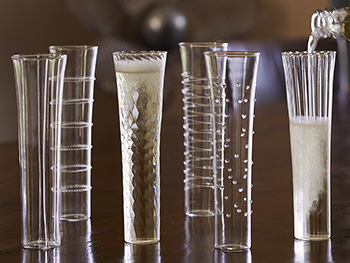
If someone trash-talks fizz, most likely his/her opinion is a direct result of experiencing a $6 bottle of warm, sweet-tart swill served in a plastic coupe, complete with detachable stem. Six more dollars would have bought them the difference between Purgatory and Hell. Sixty more? Heaven! They’d be thanking you for introducing them to the crème de la crème of fermented grape juice.
While holidays bring many column inches dedicated to our fizzy friends; this evergreen, two-chapter Sparkler Primer will be here for you 24/ 7/ 365. Enjoy!
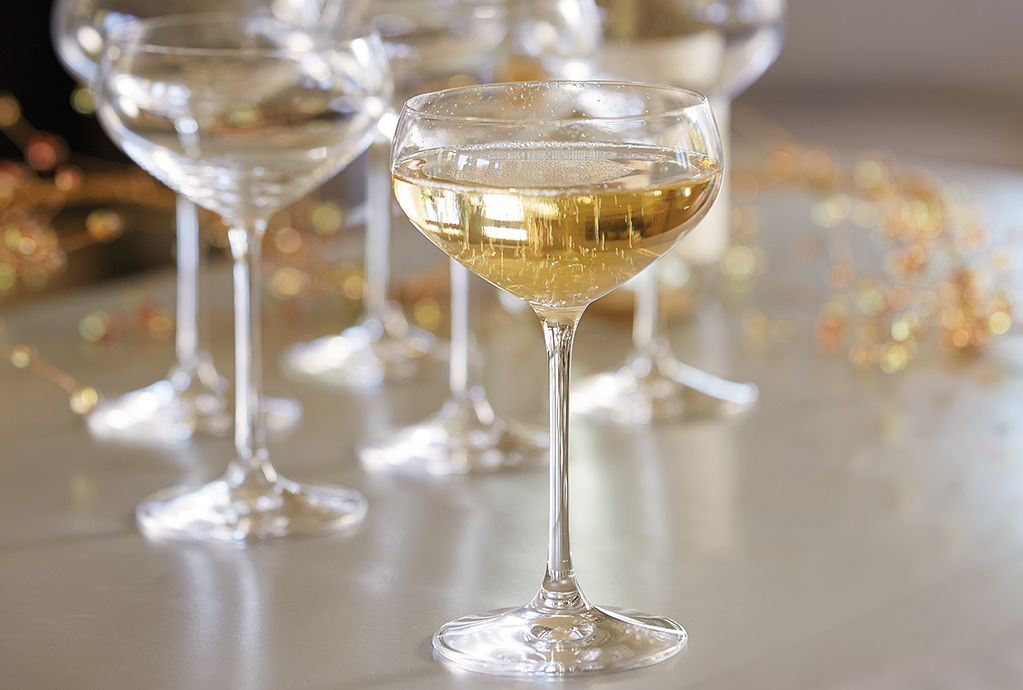
MAKING OF
- Grapes picked, pressed & fermented separately by lot, as per usual.
- Resulting ‘still’ wines (non-bubbly) tasted and profiled. Combination-experiments begin.
- Exact proportions determined for final blend (‘assemblage’).
- “Secondary fermentation”- Blended result (cuvée) is bottled and given a dose of yeast and sugar. (This process is also referred to as méthode champenoise, méthode traditionelle, or bottle-fermented.)
- Yeast burp CO2 as they stuff their faces on sugar-feast until they “can’t-take-no-more”… promptly dying, floating to bottom, and leaving yummy, burpy air tingling behind. (This also occurs in still wine, but the gas is allowed to escape.)
- Dead yeast eventually needs to be extracted or else cloudy, harmless sludge congeals.
- To achieve this, a simple but time-consuming process is initiated over 4-8 weeks:
- Bottles gradually tilted upside-down and rotated. Sediment calmly drifts into tippy-top of bottle, settling into a small receptacle (bidule).
- Manually, this process is called riddling (or remuage), done by a riddler (remueur), on a riddling rack.
- Automated, a gyropalette is manipulated daily by machine. Same result.
- Once yeast “lees” collect in bottleneck, disgorgement (dégorgement) means the bidule tips are gently lowered into freezing solution and the ice plug containing sediment ‘pops out’–leaving behind as much juice and gas as possible.
- A ‘dosage’ (doh-SAHJ) of reserved wine is promptly added with new sugar (amount determined by the intended acidity and dryness in final result.)
- Famous Champagne cork seals the deal; inserted 2/3 down, for later ‘mushroom’ appearance.
- Twisty wire caging + foil wrap insure no untimely cork explosions during further aging/ transit/ storage.
Alternative methods to traditionelle
- ‘Charmat’ is a similar procedure that occurs in large tanks instead of individual bottles and does not require riddling or disgorging. (Also ‘Tank’ or ‘Bulk’ Method; or ‘Cuve Close’).
- Carbonation – the juice is treated soda-pop-style. (Cheapest method distinguishable by large bubbles, cheap price tags and lackluster taste.)
- Transfer/ Tirage – least popular, most expensive. Delayed disgorgement allows the flavor of autolyzed yeast to develop in the wine sometimes for years before transfer into new bottles. Used in special releases.
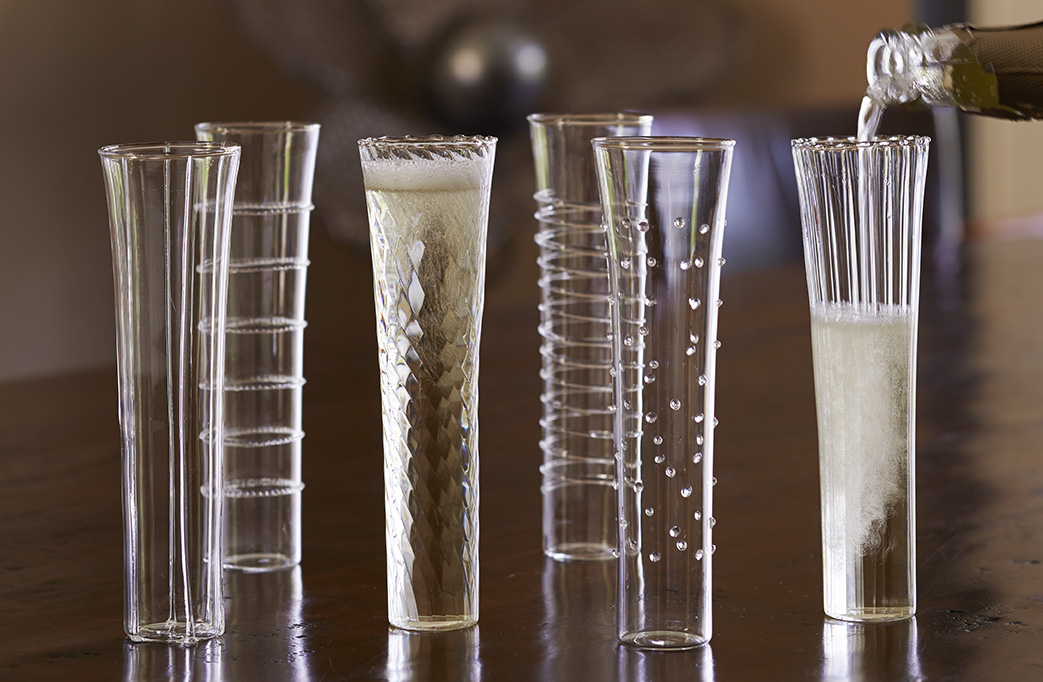
BUYING
Good bubbles don’t break the bank. Fabulous ones do. The smaller and tighter the bubbles, the more fancy, refined and pricey. Additional cues help narrow cost-effective choices for any budget:
BLANC DE BLANC or BLANC DE NOIR? [White of White VS White of Black]
Refers to grape color used. Blanc = white, so BLANC DE BLANC uses green grapes. Noir = black, so BLANC DE NOIR, black or red grapes. Many golden wines actually come from carefully-handled red or black grapes so grape skins don’t blush them. As a rule, the more pale, the more likely from green-grapes, and more acidic/ more versatile for food pairing.
In the case of Rosés (or ‘pinks’ and of course, Sparkling Reds, red/ black grapes are ALWAYS involved.
LABEL COMPARISON: YEAR VS. LETTERS “NV”?
*YEAR* = VINTAGE. Grapes harvested a same, single year and aged longer. PRICEY, because consistency is difficult to achieve year-over-year. (Some years, famous Fr Houses may forego entirely if the fruit isn’t up to snuff.)
*NV/ NON-VINTAGE (or MV/ Multi-Vintage)* = Blends of juice from different years mean consistent taste and better pricing. Still cost a pretty-penny for best brands.
(ADD) *PRESTIGE or DELUXE CUVÉE* = The “good stuff”.
“TÊTE DE CUVÉE” = ‘Thee’ Prestige Label of a major Marque (House). Top o’ the line.
DRY-TO-SWEET, IN ORDER (Range sorted by color):
Brut Nature No added sugar. Tooth-enamel-stripping bone dry.
½ step up: Extra Brut
Brut (*Most popular) ½ step up: Extra Dry/ Extra Sec/ Extra Secco/ or Extra Trocken
Dry, Sec, Secco, Trocken
Demi-sec, Semi-seco, Off-Dry, Halbtrocken
Doux, Sweet, Dulce
STORING
For those who possess the self-restraint to store bubbles (or buy large quantities at a time), these rules are your insurance policy for the best-possible ‘quaffability’:
- Maintain a constant ambient temperature ~50°F. Down to 40°F OK but not optimum.
- Humidity = Friend. Controlled wine cellars or unfinished basements best.
- Minimal light exposure. (Never direct sunlight – it produces off-flavors. Limit artificial light with shade or cover.)
- And PLEASE, no vibrations or ongoing excessive noise nearby. (Think of it as your great-grandma: lovely but sensitive.)
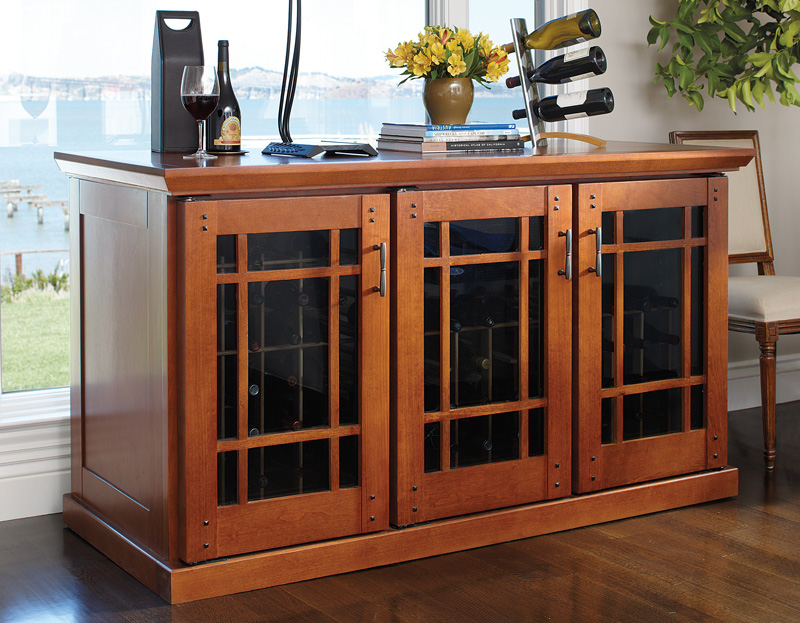
No basement? Believe it or not, this wine storage credenza features UV-protected & sealed doors with adjustable cooling & humidity! I want one!
SERVING
Ideal serving temperature:
- 47-50°F for Vintage bubbly.
- 45-47°F Non-Vintage.
Colder? Aromas harder to detect.
Warmer? Wines less bright.
The ‘Pro’ Approach:
- Chill in ice bucket: 50% ice + 50% water. 30 min.
OR
- Store bottle on side at the bottom of fridge. 3-4 hours before serving.
*Under no circumstances ‘flash’ in a freezer or serve in pre-chilled glasses. Both diminish quality.*
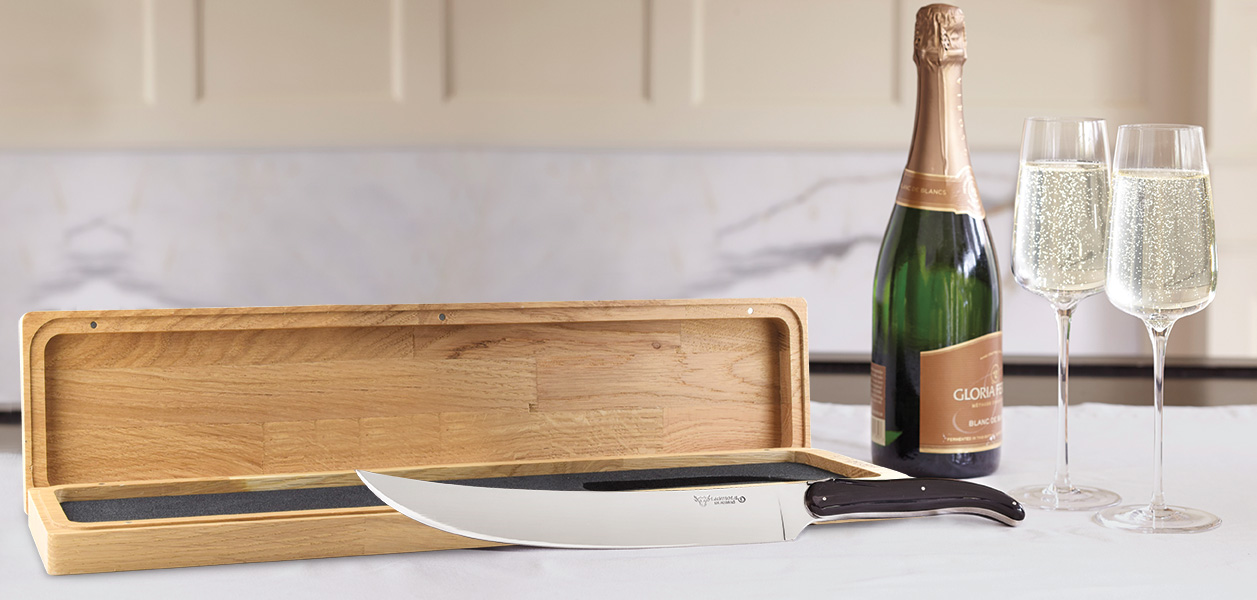
1 – OPENING
Looks simple, right? Remove foil & wire > de-cork.
But, there IS a technique. (“Popping” is bad form unless you just won a championship and intend to spray or wear it.) Avoid ‘volcano syndrome’ by holding underneath bottle in your favored hand; tilting the bottle 45° until the cork hits your other palm. Grasp the cork firmly and gently rotate the bottle—not the cork—while slowly ‘twisting and pulling’ the bottle away from the cork.
Flair for the dramatic? Sabering isn’t difficult for even the mildly coordinated.
2 – GLASSWARE
Not just for wine-snobs, bubbly glasses are designed ‘on-purpose’ to bring out its best. Size, shape and quality do matter if you have the choice in Champagne glasses.
Fine, thin glass or crystal retains delicate bubbles.
Clear glass is best and allows you to see color, clarity, bubble size and “mousse” (foaminess).
Slender, elongated shapes retain effervescence and prevent air from escaping too fast.
First – glasses must be squeaky clean! Any residues—soap, dust or otherwise—reduce fizziness.
GLASS SHAPES
FLUTES = most popular. Sometimes include a pin-prick at the bottom to hypnotize bubbles into a ‘line’ formation rushing to the surface.
TULIPS = same principle; but rim is shaped smaller than bowl to hold in delicate aromas.
HOLLOW-STEMS also follow the same principle, but require backwards head-toss to finish. Also called “Somms” because their design propels bubbles upward—a desired effect in judging.
COUPES are Audrey-Hepburn’s broad-top, flat-’round’ shape—rumored to be fashioned after Marie Antoinette’s left breast. It’s actually the worst shape for preserving a Champer’s delicate nuances, but certainly look festive and fun if you’re not drinking the ‘good’ stuff.
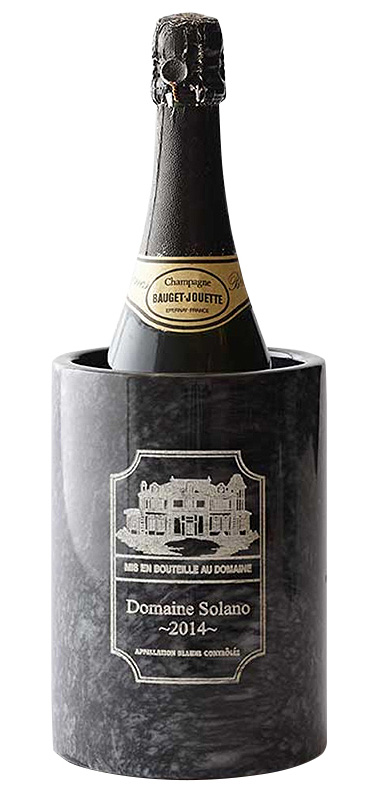
3 – POURING
A steady flow encourages bubbles to collect in glass rather than ‘mousse out’/ foam over.
Hold bottle by its base, not neck, (purpose of the punt, the indentation on the bottom.)
Pour with (three-five) pauses.
Do not fill glass more than two-thirds.
Let it ‘open’ a smidge before tasting (3-5 minutes OK.)
4 – ACCESSORIZE with any of these handy tools:
Fear dribbling on guests’ attire? Non-aerating pourers help aim & won’t make your fizz go flat.
Wine charms allow guests to keep track of glasses.
Pre-chilled wine chillers maintain bottle temp without running back and forth to the fridge or wiping down icy bottles between pours. (Be sure to get champagne-friendly sizes for larger bottles.)
And finally, why anyone would have leftover bubbly is beyond me; but if morning-after mimosas beckon, stoppers can hold the sparkle in that already-opened bottle.
We’ve covered the basics; now sharpen the saw with expert details as THEE De FACTO CHAMPAGNE PRIMER continues in Part 2
Lori Stevens, former wine magazine food editor has worked for wineries and traveled extensively through most of the world’s wine, craft beer, cider, and scotch-producing regions. Author of Wine: A No Snob Guide: Drink Outside the Box, Berkeley: Rockridge Press, 2015; she currently lives in Seattle.
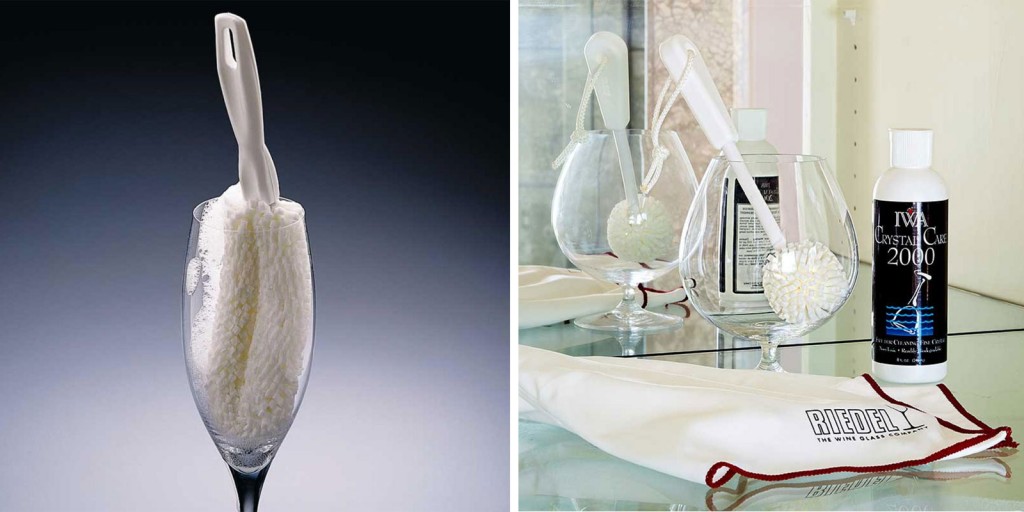
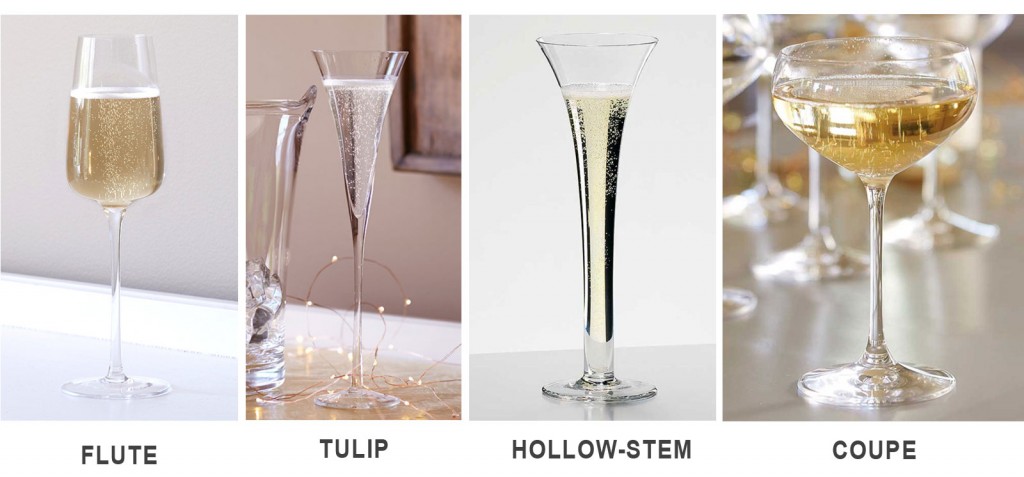
Great article. Exception to the notes on NV would be
NV Krug which sells for more than many marquis vintage champagnes. Deservedly so, as blind testings, time after time put NV Krug rating ahead of great vintage champagnes.
-Richard